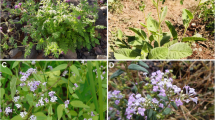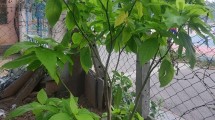Abstract
The efficacy of plant extracts (neem tree, Azadirachta indica A. Juss.; Meliaceae) and copepods [Mesocyclops aspericornis (Daday)] for the control of the dengue vector Aedes aegypti L. was tested in the laboratory. Neem Seed Kernel Extract (NSKE) at 25, 50, 100, 200 and 400 ppm caused significant mortality of Ae. aegypti larvae. Lethal concentrations (LC50 and LC90) were worked out. The LC50 and LC90 values for I to IV larval instars were 111.98, 138.34, 158.93, 185.22 ppm and for pupae was 146.13 ppm, respectively. The LC90 value of I instar was 372.95 ppm, II instar was 422.77 ppm, III instar was 440.63 ppm, IV instar was 456.96 ppm, and pupae was 476.92 ppm, respectively. A study was conducted to test the whether the predatory efficiency of copepods on first instars changed in the presence of NSKE. The percentage of predatory efficiency of copepod was 6.80% in treatments without NSKE and the percentage of predatory efficiency increased up to 8.40% when copepods were combined with NSKE. This increase in predation efficiency may caused by detrimental effects of the neem active principle compound (Azadirachtin) on the mosquito larvae. Our results suggest that the combined application of copepods and neem extract to control Aedes populations is feasible. Repeated application of neem does not cause changes in copepod populations, because neem is highly degradable in the environment.
Similar content being viewed by others
References
Abbott, W. S., 1925. A method of computing the effectiveness of insecticides. Journal of Economic Entomology 18: 267–269.
Batra, C. P., P. K. Mittal, T. Adak & V. P. Sharma, 1998. Efficacy of neem-water emulsion against mosquito immatures. Indian Journal of Malariol 35: 15–21.
Breakley, C. J., P. L. Crampton, F. E. Ricket & P. R. Chadwick, 1984. Resistance mechanisms to DDT and transpermethrin in Aedes aegypti. Pesticide Science 15: 121–133.
Collado, C. D., D. Defaye, B. H. Dussart & C. H. Fernando, 1984. The freshwater Copepoda of Costa Rica with notes on some species. Hydrobiologia 119: 89–99.
Finney, D. J., 1971. Probit Analysis. Cambridge University, London: 68–78.
Guzman, M. G. & G. Kouri, 2002. Dengue: an update. Lancet Infectious Diseases 2: 33–42.
Harrington, L. C., T. W. Scott, K. Lerdthusnee, R. C. Coleman, A. Costero, G. G. Clark, J. J. Jones, S. Kitthawee, P. Kittayapong, R. Sithiprasasna & J. D. Edman, 2005. Dispersal of the dengue vector Aedes aegypti within and between rural communities, part 1. American Journal of Tropical Medicine Hygiene 72: 209–220.
Hernández-Chavarría, F. & S. Schaper, 2000. Mesocyclops thermocyclopoides (Copepoda: Cyclopoidea): a scanning electron microscopy study. Review Latino American of Microbiology 42: 53–56.
Honório, N. A., W. C. Silva, P. J. Leite, J. M. Gonçalves, L. P. Lounibos & R. Lourenço-de-Oliveira, 2003. Dispersal of Aedes aegypti and Aedes albopictus (Diptera: Culicidae) in an urban endemic dengue area in the state of Rio de Janeiro, Brazil. Memorias do Instituto Oswaldo Cruz 98: 191–198.
Hurlbut, H. S., 1938. Copepod observed preying on first instar larva of Anopheles quadrimaculatus. Journal of Parasitology 24: 281.
Isman, M. B., 2006. Botanical insecticides, deterrent and repellents in modern agriculture and an increasingly regulated world. Annual Review of Entomology 51: 45–66.
Jekow, P., S. Schaper, D. Günther, P. Tavares & W. Hinrichs, 1998. Crystallization and preliminary X-ray crystallographic studies of the 13-fold symmetric portal protein of bacteriophage SPP1. Acta Crystallographica Section D Biological Crystallography 54(Pt 5): 1008–1011.
Kamala Kannan, S., K. Murugan, A. Naresh Kumar, N. Ramasubramanian & P. Mathiyazhagan, 2008. Adulticidal effect of fungal pathogen, Metarhizium anisopliae on malarial vector Anopheles stephensi (Diptera: Culicidae). African Journal of Biotechnology 7(6): 838–841.
Kay, B. H., C. P. Cabral, A. C. Sleigh, M. D. Brown, Z. M. Ribeiro & A. W. Vasconcelos, 1992. Laboratory evaluation of Brazilian Mesocyclops (Copepoda: Cyclopidae) for mosquito control. Journal of Medical Entomology 29: 599–602.
Kosiyachinda, P., A. Bhumiratana & P. Kittayapong, 2003. Enhancement of the efficacy of a combination of Mesocyclops aspericornis and Bacillus thuringiensis var. israelensis by community-based products in controlling Aedes aegypti larvae in Thailand. American Journal of Tropical Medicine and Hygiene 69: 206–212.
Kumar, R. & J. S. Hwang, 2005. Feeding modes and associated mechanisms in zooplankton. In Kumar, A. (ed.), Ecology of Plankton. Daya Publishing House, New Dehli: 228–265.
Kuno, G., 1995. Review of the factors modulating dengue transmission. Epidemiology Reviews 17: 321–335.
Lardeux, F., F. Riviere, Y. Sechan & B. H. Kay, 1992. Release of Mesocyclops aspericornis (Copepoda) for control of larval Aedes polynesiensis (Diptera: Culicidae) in land crab burrows on an atoll of French Polynesia. Journal of Medical Entomology 29: 571–576.
Lardeux, F., F. Riviere, Y. Sechan & S. Loncke, 2002. Control of the Aedes vectors of the dengue viruses and Wuchereria bancrofti: the French Polynesian experience. Annals of Tropical Medicine and Parasitology 96: S105–S116.
Locantoni, L., F. Guisti, M. Cristofaro, L. Pasqualini, F. Esposito, P. Lupetti & A. Habluetzel, 2006. Effect of neem extract on blood feeding oviposition and oocyte ultra structure in Anopheles stephensi Liston (Diptera: Culicidae). Tissue Cell 38: 361–371.
Manrique-Saide, P., S. Ibanez-Bernal, H. Delfin-Gonzalez & V. Parra Tabla, 1998. Mesocyclops longisetus effects on survivorship of Aedes aegypti immature stages in car tyres. Medical Veterinary Entomology 12: 386–390.
Marten, G. G., R. Astaiza, M. F. Suarez, C. Monje & J. W. Reid, 1989. Natural control of larval Anopheles albuminus (Diptera: Culicidae) by the predator Mesocyclops (Copepoda: Cyclopoida). Jouranl of Medical Entomology 26: 624–627.
Marten, G. G., 1990. Elimination of Aedes albopictus from tire piles by introducing Macrocyclops albidus (Copepoda, Cyclopidae). Journal of American Mosquito Control Association 6: 689–693.
Marten, G. G., G. Borjas, M. Cush, E. Fernández & J. W. Reid, 1994. Control of larval Aedes aegypti in peridomestic breeding containers. Journal of Medical Entomology 31: 36–44.
Muir, L. E. & B. H. Kay, 1998. Aedes aegypti survival and dispersal estimated by mark-release-recapture in northern Australia. American Journal of Tropical Medicine Hygiene 58: 277–282.
Murugan, K., 2004. Chemical and botanical pesticides on their impact on the biological control agents on insects. In Albanis, T. A. (ed.) Proceedings of the 3rd European conference on pesticides and related organic micropollutants in the environment. University of Ioannina, Greece: 445–450.
Murugan, K. & G. Vanithakumari, 2009. Integration of botanical and microbial pesticides for the sustainable management of insect–pests. In Singh, K. K., Phogat Suman, Tomar Alka & R. S. Dhilon (eds), Neem: A Treatise. I.K. International Publising House Pvt. Ltd., New Delhi, India: 299–315.
Murugan, K., P. Thangamathi & D. Jeyabalan, 2002. Interactive effect of Botanicals and Bacillus thuringiensis subsp. sisraelensis on Culex quinquefasciatus Say. Journal of Scientific & Industrial Research 61: 1068–1076.
Murugan, K., R. Vahitha, I. Baruah & S. C. Das, 2003. Integration of botanicals and microbial pesticides for the control of filarial vector Culex quinquefasciatus. Annals of Medical Entomology 12(1 and 2): 11–23.
Murugan, K., P. Murugan & A. Noortheen, 2007. Larvicidal and Repellent potential of Albizzia amara and Ocimum basilicum against dengue vector, Dengue vector, Aedes aegypti Liston (Insecta: Diptera: Culicidae). Bioresource Technology 98(1): 198–201.
Nam, V. S., N. T. Yen, B. H. Kay, G. G. Marten & J. W. Reid, 1998. Eradication of Aedes aegypti from a village in vietnam, using copepods and community participation. American Journal of Tropical Medicine and Hygiene 59: 657–660.
Nam, V. S., N. T. Yen, M. Holynska, J. W. Reid & B. H. Kay, 2000. National progress in dengue vector control in Vietnam: survey for Mesocyclops (Copepoda), Micronecta (Corixidae), and fish as biological control agents. American Journal of Tropical Medicine Hygiene 62: 5–10.
National Research Council, 1992. Neem: a tree for solving global problems. Report of an ad hoc panel of the Board on Science and Technology for International Development. National Academy Press, Washington.
Rao, D. R., R. Reuben, M. S. Venugopal, B. A. Nagasampgi & H. Schmutterer, 1992. Evaluation of neem—Azadirachta indica with and without water management for the control of culicine mosquito larvae in rice field. Medical Veterinary Entomology 6: 318–324.
Rawlins, S. C., R. Martinez, S. Wiltshire, D. Clarke, P. Prabhakar & M. Spinks, 1997. Evaluation of Caribbean strains of Macrocyclops and Mesocyclops (Cyclopoida: Cyclopidae) as biological control tools for the dengue vector Aedes aegypti. Journal of the American Mosquito Control Association 13: 18–23.
Rishikesh, N., A. M. Dubitiskij & C. M. Moreau, 1988. Malaria vector control. Biological Control 118: 1227–1250.
Riviere, F. & R. Thirel, 1981. La predation du copepods Mesocyclops leuckarti pilosa sur les larves de Aedes (Stegomyia) aegypti et Ae. St. polynesiensis essais preliminaires d’utilization comme de lutte biologique. Journal of Entomophaga 26: 427–439.
Riviere, F., B. H. Kay, J. M. Klein & Y. Sechan, 1987. Mesocyclops aspericornis (Copepoda) and Bacillus thuringiensis var. israelensis for the biological control of Aedes and Culex vectors (Diptera: Culicidae) breeding in crab holes, tree holes, and artificial containers. Journal of Medical Entomology 24: 425–430.
Russell, B. M., L. E. Muir, P. Weinstein & B. H. Kay, 1996. Surveillance of the mosquito Aedes aegypti and its biocontrol with the copepod Mesocyclops aspericornis in Australian wells and gold mines. Medical and Veterinary Entomology 10: 155–160.
Schaper, S., 1999. Evaluation of Costa Rican copepods (Crustacea: Eudecapoda) for larval Aedes aegypti control with special reference to Mesocyclops thermocyclopoides. Journal of American Mosquito Control Association 15: 510–519.
Schmutterer, H., 1990. Properties of natural pesticides from the neem tree, Azadirachta indica. Annual Review of Entomology 35: 271–297.
Schmutterer, H., 2002. The Neem Tree (Azadirachta indica) and Other Meliaceous plants: Source of Unique Natural Products for Integrated Pest Management, Medicine, Industry and Other Purposes. 1. Neem Foundation, Mumbai
Sharma, V. P. & R. C. Dhiman, 1993. Neem oil as a sand fly (Diptera: Psychodidae) repellent. Journal of American Mosquito Control Association 9: 364–366.
Spielman, A., U. Kitron & R. J. Pollack, 1993. Time limitation and the role of research in the worldwide attempt to eradicate malaria. Journal of Medical Entomology 30: 6–19.
Su, T. & M. S. Mulla, 1998a. Ovicidal activity of neem products (azadirachtin) against Culex tarsalis and Culex quinquefasciatus (Diptera;Culicidae). Journal of American Mosquito Control Association 14: 204–209.
Su, T. & M. S. Mulla, 1998b. Antifeedancy of neem products containing Azadirachtin against Culex tarsalis and Culex quinquefasciatus (Diptera: Culicidae). Journal of Vector Ecology 23: 114–122.
Tietze, N. S., P. G. Hester, K. R. Shaffer, S. J. Prescott & E. T. Schreiber, 1994. Integrated management of waste tire mosquitoes utilizing Mesocyclops longisetus (Copepoda: Cyclopidae), Bacillus thuringiensis var. israelensis, Bacillus sphaericus, and methoprene. Journal of American Mosquito Control Association 10: 363–373.
Williamson, C. E., 1999. Ecology and Classification of North American Freshwater Invertebrates. Academic Press Inc, San Diego: 787–822.
Acknowledgments
We thank Professor William Walton, Department of Entomology, University of California Riverside, USA for critically going through the manuscript and Dr. Y. Ranga Reddy, Department of Zoology, Acharya Nagarjuna University, Andhra Pradesh, India for the identification of Copepods for our experiment. We acknowledge the financial support from National Science Council, Taiwan grant no. NSC 98-2621-B-019-001-MY3.
Author information
Authors and Affiliations
Corresponding author
Additional information
Guest editors: J.-S. Hwang and K. Martens / Zooplankton Behavior and Ecology
Rights and permissions
About this article
Cite this article
Murugan, K., Hwang, JS., Kovendan, K. et al. Use of plant products and copepods for control of the dengue vector, Aedes aegypti . Hydrobiologia 666, 331–338 (2011). https://doi.org/10.1007/s10750-011-0629-0
Published:
Issue Date:
DOI: https://doi.org/10.1007/s10750-011-0629-0




